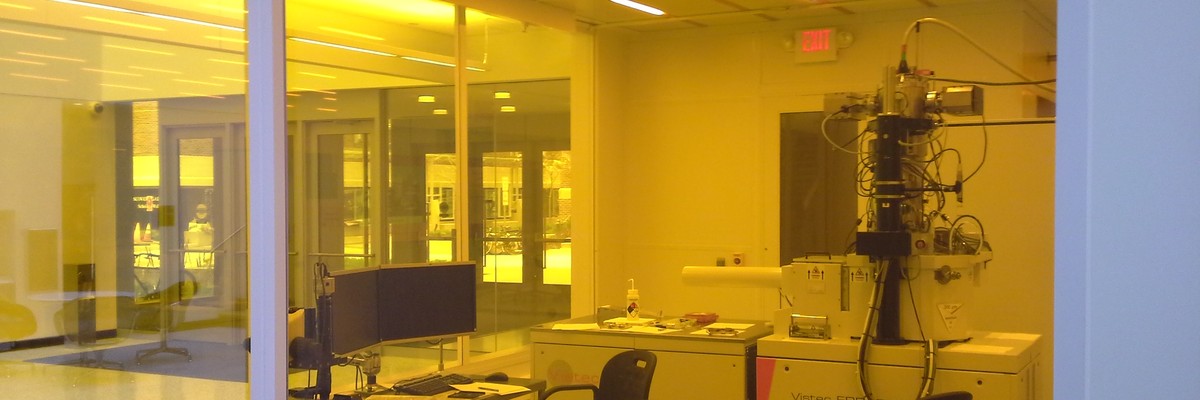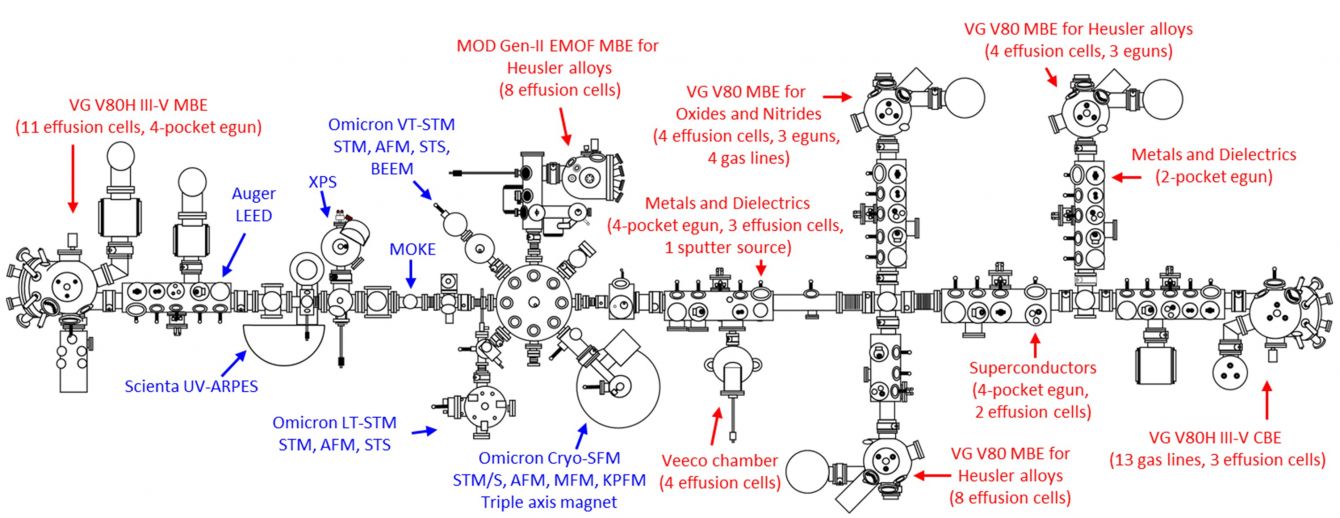Prigbiag and Crowell:
Minnesota Nano Center: The University of Minnesota maintains a state of the art fabrication facility, Minnesota Nano Center (MNC), with a 3000 square foot class-100 cleanroom and a new 5000 square foot class-100 cleanroom, dedicated to fabricating sub-100 nm nanostructures. For more information on the equipment available at the MNC, please visit https://www.mnc.umn.edu/.

College of Science and Engineering Characterization Facility: The University of Minnesota College of Science and Engineering Characterization Facility (CharFac) provides access to a large suite of characterization techniques including but not limited to wide angle x-ray diffraction, x-ray reflectivity, and atomic force microscopy. For more information on the equipment used at this facility, please visit https://cse.umn.edu/charfac.
Minnesota Supercomputing Institute: The Minnesota Supercomputing Institute (MSI) hosts two computing clusters, Mesabi and Mangi. Mesabi is an HP Linux distributed cluster featuring a large number of nodes with leading edge Intel processors that are tightly integrated via a very high speed communication network. In addition, it contains a significant number of nodes with very large memory (up to 1 TB per node), accelerator nodes (GPU), and nodes with solid state storage devices (SSD) for ultra high performance input/output. Mangi is an expansion to Mesabi, including ten nodes with large memory (2 TB per node). For more information, please see https://www.msi.umn.edu/.
Physics Shared Facilities: Several instruments are available in departmental laboratories. Shared instruments include a Quantum Design Physical Properties Measurement System (PPMS) (1.5 – 400 K, 9 T) and a SQUID magnetometer (2 – 300 K, 5 T).
Crowell Lab:
Cryogenics: Two flow cryostats are outfitted for high precision (< 1 mK at 10 K) temperature regulation with temperature range from 10 K to 300 K. Each cryostat is outfitted with a complete set of low-noise dc transport electronics. A sample insert for microwave measurements is used with one of these systems. These two systems use electromagnets with ranges up to 5 kOe.
Microwave Electronics: A 20 GHz microwave synthesizer, 26.5 GHz spectrum analyzer, and sampling oscilloscope are in the PI’s laboratory. Two fast pulse generators can be used: a Picosecond Pulse Labs 2000 provides 0.5 nsec rise-time pulses (50 V into 50 ohms) while a Model 10060A provides 55 psec rise-time pulses (10 V into 50 ohms). A 20 GHz real-time oscilloscope is available on a shared basis.
Pribiag Lab:

Milli-Kelvin measurement systems: An Oxford Triton dry dilution refrigerator with rapid sample-exchange mechanism is available in the PI's laboratory. The dilution refrigerator is equipped with thermalized DC and microwave signal lines and has a base temperature of 13 mK. The refrigerator is also equipped with a 3-axis 6T-1T-1T vector magnet. A second dry dilution refrigerator (Bluefors) with base temperature of <10 mK is also available in the PI’s laboratory. It is equipped with thermalized DC and microwave signal lines and a 9T-3T vector magnet, complementing the Oxford system.
2-Kelvin cryostat: A liquid He cryostat, capable of temperatures down to 1.8 K is also available in the PI’s laboratory. The setup is equipped with an 8T split-coil magnet that allows full in-plane sample rotation with respect to the applied field.
Low-noise measurement electronics: Both the dilution refrigerators and the 2-Kelvin system are integrated with state-of-the-art low-noise modular electronic measurement setups (http://qtwork.tudelft.nl/~schouten/ivvi/index-ivvi.htm).
Microwave electronics: A 20-GHz microwave source, 26-Ghz spectrum analyzer and a 2-8 GHz cryogenic amplifier are also available in Pribiag’s lab for microwave experiments down to mK temperatures.
Transfer station with nanomanipulator: A custom-designed transfer station capable of precise placement of individual nanowires and van der Waals materials with sub-micron accuracy is available for nanomaterial assembly in ambient.
Marom:
Carnegie Melon University: The Arjuna high-performance computing (HPC) cluster is located at the Pittsburgh Supercomputing Center (PSC). It has 70 nodes with dual Intel Xeon E5-2680 V4 processors each (a total of 28 cores per node) and 128 GB RAM and two additional nodes with dual Intel Xeon E5-2620 V4 each (a total of 16 cores per node) and 128 GB RAM. All nodes are connected by an Intel InfiniBand switch. Each node has a 100 GB SSD for data storage.
Frolov Lab:

Cryogenics: Measurements within this project will be performed at millikelvin temperatures in dilution refrigerators. One Oxford Triton cryogen-free dilution refrigerator and a complete setup for electrical measurements (digital-to-analog convertors, current amplifiers, lock-in amplifiers) is available for this purpose. This dilution refrigerator is equipped with an 8 Tesla solenoid magnet and will be the primary cryostat for this project. Two additional Leiden Cryogenics dilution refrigerators are installed in the Frolov lab. These refrigerators allow simultaneous measurements on two samples each. One of the refrigerators has a 9 Tesla solenoid magnet, the other one has a two-axis 6 Tesla – 4 Tesla magnet for in-situ magnetic field rotation.
Sample Preparation: Frolov’s lab also has a setup for micropositioning of nanowires on silicon chips, integrated with the probe station. This setup allow picking up individual nanowires from the growth chip and depositing them in a controlled fashion and orientation on the device chip. The same setup is equipped with electrical probes for evaluating the final devices at room temperature. A wirebonder setup for making electrical connections between the nanoscale devices and the measurement cables is also installed in the Frolov lab.
Fabrication Facilities: Shared facilities at the University of Pittsburgh Peterson Institute of NanoScience and Engineering (PINSE) will be used to perform nanofabrication of devices based on semiconductor nanowires. PINSE is a state-of-the-art facility for lithography and materials characterization, as well as technical support. The following equipment is available for use in the cleanroom: wet bench processing, resist spinning, electron-beam lithography, wet (acid) etching, oxygen plasma cleaning, electron-beam evaporation, and magnetron sputtering. For more details on PINSE please visit their website at http://www.nano.pitt.edu/.
Palmstrøm Lab:

Growth Facilities: Palmstrøm’s interconnected UHV growth and characterization system includes a modified VG V80H MBE for As- and Sb-based III-V semiconductors and As-, Sb-, and Ga-based metallic compounds including Rare-earth-group-V (RE-V); a modified Gen-II EMOF MBE for full-Heusler, half-Heusler and RE-V compound growth; a VG V80 MBE system for Ni, Ti, Fe, and Co based full and half-Heusler compounds; a VG V80 for metal oxide/nitride growth; an additional VG V80 being converted to Heusler compound growth with metal organic sources (MOMBE); and a VG V80H chemical beam epitaxy (CBE) growth system for As-, P-, and Sb-based III-Vs. Additional deposition capabilities in the system include a Veeco deposition chamber with 4 effusion cells (includes Pb), plus three 4 pocket e-guns for elemental metals and dielectrics and additional effusion cells in UHV transfer chambers for Al, Au, and Ag deposition and atomic hydrogen cleaning. One of these transfer chambers is equipped with a cryogenic (LN 2) sample stage that allows for sample cooling during superconductor deposition.
Characterization Facilities: These growth and deposition systems are complemented by a number of in-situ surface characterization tools, including an Omicron variable temperature (50-750K) scanning probe microscope (STM and AFM) with ballistic emission electron microscopy (BEEM), an Omicron low temperature scanning probe microscope (STM and AFM) (~2.5-300K), an Omicron Cryo-SFM (AFM and STM) (~5K) attached to a flow cryostat that can be inserted into a triple axis superconducting vector magnet (1T-1T-5T) with optical access, Auger and x-ray photoelectron spectroscopies, reflection high energy diffraction in all MBE growth chambers, low energy electron diffraction, and magneto optic Kerr effect (MOKE) measurements. Device structures can be fabricated using shadow masks with features sizes below 0.5 µm that can be attached and removed in-situ. A UHV vacuum suitcase allows for sample transfer from the Palmstrøm lab growth and characterization facility to other UHV systems for further sample characterization at other laboratories, such as ARPES at ALS.